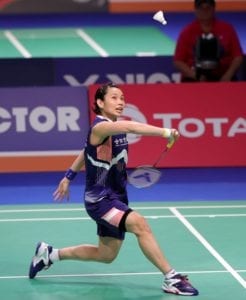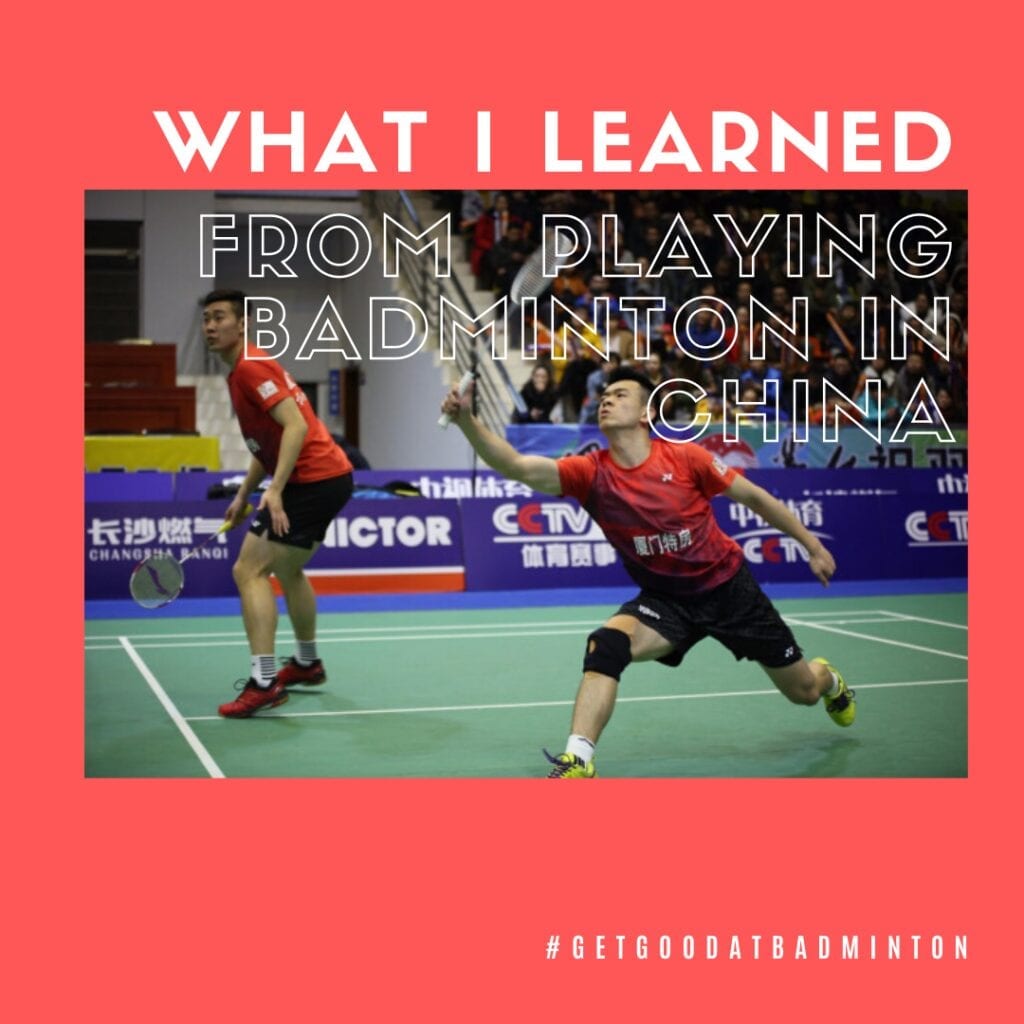After about three weeks of training in China, I learned a lot about badminton. Training in China allowed me to take a completely different perspective of badminton as a game. In this post, I will tell you about what I learned from playing badminton in China.
This post is sort of like a follow-up post to my Badminton Training Program In China post, where I talk about the structure of the training and the types of drills I did in China.
You can check that post out here: Badminton Training Program In China (An In-Depth Guide)
This post, however, I will be going through some of the other things I learned that you could apply in your games.
How To Create Super Steep Angles
When I was training in China, the coaches saw lots of issues with my swing after watching me play various drop shots and smashes.
I could never produce a great angle on these shots.
My drop shots were often too high above the net, either giving my opponent time to recover on the defense or an opportunity to end the rally right away.
My smashes were up at my opponent’s body, allowing him to quickly use all the power that I had generated against me to play a block angled downward on my side.
My coach was looking at my swing and saying that I needed to angle my shots down more by hitting the shuttle with my racket face at a lower point.
I needed to hit the shuttle at a lower contact point to get a steeper angle on my shot.
My coach said that any contact point as long as it’s before your arm becoming parallel with ground is fine, so do your best to hit it at the lowest point possible.
Then he told me to do some shadow drills. He said to swing my racket slowly and look at my contact point and envision myself hitting the shuttle.
That’s what I did a lot.
Whenever I had the chance, I would pull out my racket and swing my racket slowly looking at my contact point for smashes and drops.
The other thing he told me to do was explicitly focus on the moments directly before contacting the shuttle. He wanted me to focus on the flexibility of my wrist and forearm rotation.
I practiced that shadow movement a lot, and it helped me focus on how to create steeper angles in my smashes and drops.
Badminton Is A Game Of Speed, Not Strength
My backhand sucks, and my coach and teammates found that out.
We were drilling backhand clears, and I just couldn’t do it. The clears were always inconsistent and to the middle of the court. I didn’t practice this shot enough as I always made it through playing drop shots.
My coach and some of the other players tried to give me some advice on my swing. Stuff about how I should flick my arm faster, hit it higher, etc., but it didn’t click.
Later on in the week, I went to have a mini private lesson with a friend of my grandparents.
She was a gym teacher in her 40s who used to play badminton competitively and was kind enough to give me a few tips and pointers on badminton and feed me a few shots.
At the gym, I asked to practice my backhand clear. After a few swings, I was still frustrated at my backhand clear.
Luckily, one of the coaches for Changsha’s top school team was there, and my teacher asked him to give me some pointers.
I went through a whole reform on my swing starting from the beginning. The coach taught me Taufik Hidayat’s backhand form, and currently, I’m still practicing it.
The new form has undoubtedly made my backhand drops cleaner. Now I’m focusing on improving my clears.
Here are a few backhand drills that you could try as well: Badminton Backhand Drills – Improve Your Backhand
The coach that taught me a new backhand form said two essential things.
- Badminton is a game of speed, not strength.
- Playing a backhand shot should feel super relaxed.
Sometimes, my clears and smashes on both my forehand and backhand suck.
I can distinctively remember some jump smashes.
I would tense every muscle in my body up, jump up, and swing as hard as I could. I either end up smashing into the ground or producing a shot that my opponent easily deflects.
Either way, it was not a good fate for me.
I couldn’t produce as much power as I wanted to, especially in a climate where it’s much more humid, and shuttles fly a lot slower than here in Canada.
After getting a few pointers for my backhand shot, I learned that the two tips I listed above applies to everything.
If I wanted a huge power smash or effortless clears, I needed to be relaxed and focused on hitting the shuttle fast instead of focusing on using as much force as possible.
The Art Of Slice Drop Shots
Chinese players love to slice. Nobody plays drop shots by slowing their swing down. Everybody just slices the shuttle.
I should practice my drop shots a lot more. When I went to China, my drop shots were pretty horrible.
Either I hit it into the net or I hit a drop shot that was way too high and slow, allowing my opponent to net kill. Another problem was my aim. It seemed like I was always hitting the shuttle to the middle.
Thus, my coach got me to practice slicing the shuttle for more drop shots.
In the beginning, it was quite challenging to get the hang of it. Things were worse than before.
Slicing requires a ton of practice. You have to slice it just enough at a certain angle to produce your desired shot. Otherwise, they fly out of the sidelines, or there’s not enough power to get the shuttle past the net.
Over time, I got better. My slice drop shots still aren’t as good as I would like them to be, but things are improving.
The most noticeable difference between a slice drop shot and a regular drop shot is how deceptive you become. After a bit of practice, my cross-court slice drops from the forehand side has gotten really good.
I’ve been getting nearly half of my points in all matches from my forehand slice drop consistently.
What makes a slice drop so powerful is because you’re swinging your racket at the same speed as a smash or clear. Opponents often anticipate a smash or clear and start moving back, not realizing that you’re playing a drop shot.
Then it’s too late, and your opponent is either forced into a bad situation or loses the point.
You can still produce the same deceptive results with a regular drop shot, but it’s not nearly as comfortable.
Regular drop shots are created with the same swing as a smash except slowing down last second before hitting the shuttle to create a slower shot.
The slowing down last-second part is challenging to accomplish. Most players will start their swing slow. While you can still produce good quality drop shots, your opponent can see you swing slowly and will expect a drop shot.
If you start your swing fast, you might not be able to slow down as fast, so you’ll end up playing a half-smash or full smash, which is entirely different from a drop shot.
With a slice drop shot, it’s much easier to be deceptive because you’re swinging your racket at the same speeds as all other shots. It makes it a lot more difficult for the opponent to react.
Here are some drills you can do as well to practice your drop shot: Badminton Drop Shot Drills
The Aggressive Flat Badminton Playstyle
In addition to slice drop shots, I also noticed that Chinese players love to play flat and aggressive in singles. It’s completely different from the slower-paced rallies that I’m used to.
We were doing attack and defense drills, and I was quite surprised when I was supposed to be attacking. It didn’t feel like I was attacking because all the lifts were so flat and fast, I almost always had to play defensively.


Again, over time, I got used to it.
It caused me to become a more explosive player. On the court, I had to be able to jump up and smash down flat lifts instantly, or else they would become too low, and I’d be forced into playing a clear or drop.
On the defense, I had to react to a lot more drives. I would lift, then my opponent would smash. Then I would block, and my opponent would drive it at me.
When I played a few games against other people, they regularly made flat pushes towards my forehand and backhand. To match their aggressiveness, I needed to be a lot faster and learn how to force these pushes to my advantage.
I had also subconsciously adapted parts of the Chinese aggressive badminton playstyle.
When I came back to my old club, I was able to severely pressure some of the players I was playing against and won a lot of points by pressuring players to the back with flat pushes.
I’ve also started driving at players more often. This increase in pace was too much for many of the players I faced. The only problem was that it sapped a lot of energy for me as well.
Time to do a ton of endurance training!
Conclusion – What I Learned Playing Badminton In China
These were some of the key takeaways from China. For a quick recap, here are quick summaries for what I learned.
- Do tons of shadow movements focusing on wrist and forearm movements in an overhead swing to create steeper angles.
- Be relaxed. Stop trying to swing so hard and think of swinging fast instead to generate power.
- Use a slice on my drop shots to become more deceptive on the court.
- Up my pace and play flat pushes and drives to create extra pressure on my opponent.
I hope you can also take away a few new learnings and try some of the things I talked about today in your game. If you have any questions or comments, please leave them down below.
Good luck in your games and have a great day!


Thanks,that was really helpful!I tried using your strategies and they helped a lot.I am also looking forward of watching you play against people like Lee Chong Wei.I would look at them when I have free time in school.I also wrote about you for a famous person project in school.I also have a question:how do you make your smashes so powerful,where were you trained and how long were you trained?
Thank you for your kind words! For smashes, the first priority you should focus on is your form and technique which can be trained by doing practice swings and having someone hit shuttles for you to hit. The second priority would be to train your overall strength which can be trained by doing exercises such as push-ups, pull-ups, as well as various weight training exercises.
I personally trained in multiple locations for a couple of years. I’m currently spending a lot of time in Calgary at Sunridge Badminton Centre.
Hope that helps!